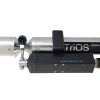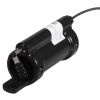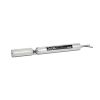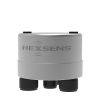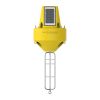TriOS NICO UV Nitrate Sensor
Features
- Internal compensation for temperature, turbidity, and organic substances
- RS-485 Modbus RTU output for integration with data collection platforms
- Optional W55 V2 wiper cleans optics & reduces maintenance intervals
- Expedited repair and warranty service
- Lifetime technical support
- More
Overview
The TriOS NICO is a low-cost UV photometer for online measurement of nitrate in lakes/rivers, drinking water, and wastewater applications. The four detection channels enable a precise optical determination of nitrate by absorption, taking into account turbidity and organic substances that pose a problem for many products currently on the market. An internal temperature correction additionally increases stability of the measured values.
Easy Configuration
The TriOS NICO is compatible with the G2 interface box, allowing fast and easy configuration of the sensors using a web browser. The sensor can be easily integrated into existing process control systems and external data loggers using the native RS-485 Modbus RTU output, and the optional W55 V2 wiper reduces maintenance intervals by cleaning the optics before each measurement.
|
Light Source
|
Xenon flash lamp
|
|
|
Detector
|
4 photo diodes + filter
|
|
|
Measurement principle
|
Attenuation
|
|
|
Optical path
|
0.3mm, 1mm, 2mm, 5mm, 10mm, 20mm, 50mm
|
|
|
|
||
|
Parameter
|
NO3-N, NO3, NOx-N, NOx (calibrated with NO3 standard solution)
|
|
|
Measurement range at 1mm path
|
0.5...60 mg/L NO3-N
|
|
|
Measurement range at 10mm path
|
0.05...6 mg/L NO3-N
|
|
|
Measurement accuracy
|
± (5% + 0.1 mg/L NO3-N) with 10mm path
± (5% + 1 mg/L NO3-N) with 1mm path
|
|
|
Turbidity compensation
|
Yes
|
|
|
Data logger
|
~2 GB
|
|
|
T100 response time
|
20 s
|
|
|
Measurement interval
|
≥ 10 s
|
|
|
|
||
|
Housing material
|
Stainless steel (1.4571/1.4404) or titanium (3.7035)
|
|
|
Dimensions (L x Ø)
|
~ 470 mm x 48 mm (10mm path)
|
~ 18.5“ x 1.9“ (with 10mm path)
|
|
Weight stainless steel
|
~ 3 kg
|
~ 6.6 lbs
|
|
Weight titanium
|
~ 2 kg
|
~ 4.4 lbs
|
|
|
||
|
Interface digital
|
Ethernet (TCP/IP), RS-485 (Modbus RTU)
|
|
|
Power consumption
|
≤ 7 W
|
|
|
Power supply
|
12...24 VDC (±10%)
|
|
|
|
||
|
Maintenance effort
|
≤ 0.5 h/month (typical)
|
|
|
Calibration/maintenance interval
|
24 months
|
|
|
System compatibility
|
Modbus RTU
|
|
|
Warranty
|
1 year (EU: 2 years)
|
US: 2 years
|
|
|
||
|
Max. pressure with SubConn
|
30 bar
|
~ 435 psig
|
|
Max. pressure with fixed cable
|
3 bar
|
~ 43.5 psig
|
|
Max. pressure in FlowCell
|
1 bar, 2...4 L/min
|
~ 14.5 psig at 0.5 to 1.0 gpm
|
|
Protection type
|
IP68
|
NEMA 6P
|
|
|
||
|
Sample temperature
|
+2...+40 °C
|
~ +36 °F to +104 °F
|
|
Ambient temperature
|
+2...+40 °C
|
~ +36 °F to +104 °F
|
|
Storage temperature
|
-20...+80 °C
|
~ -4 °F to +176 °F
|
|
Inflow velocity
|
0,1...10 m/s
|
~ 0.33 to 33 fps
|
In The News
Data in Action: Heidelberg’s Nutrient Monitoring in Great Lakes Tributaries
In the early hours of the morning, when most people have yet to hit snooze for the first time, water sampling sites across Ohio are awake and actively collecting nutrient data. The samplers are active at noon, eight in the evening and four in the morning, but very few people would know or even think about the equipment. Included in those few is Jakob Boehler, field manager for the National Center for Water Quality Research (NCWQR) at Heidelberg University. For Boehler, these systems booting up every day represents valuable data points that will be used to educate the public, influence environmental policies and support future research. “There are 20 of these samplers going off across the state of Ohio and Southeast Michigan.
Read MoreSargassum Surge: How Seaweed is Transforming our Oceans and Coastal Ecosystems
Until recently, Sargassum –a free-floating seaweed–was distributed throughout the Sargasso Sea , the north Caribbean Sea, and the Gulf of Mexico. But in the space of a decade, this seaweed has, as one scientist remarks , “Gone from a nonfactor to the source of a terrible crisis.” Driven by climate change, anomalous North Atlantic Oscillation in 2009-2010 and a glut of anthropogenic pollutants, sargassum has proliferated. Seasonally recurrent mats as deep as 7m now bloom in the “Great Atlantic Sargassum Belt” (GASB), which covers areas of the Atlantic from West Africa to the Caribbean Sea and Gulf of Mexico. Every year, millions of tons wash up along the shores of more than 30 countries . Dr.
Read MoreGreat Lakes Research Center: Designing Targeted Monitoring Solutions
According to the National Oceanic and Atmospheric Administration ( NOAA ), the Great Lakes have more miles of coastline than the contiguous Atlantic and Pacific coasts combined and contain 20 percent of the world's freshwater, making it a critical region to protect and conserve. Continuous monitoring and data-informed resource management are key components of managing waters in the region. Hayden Henderson, a research engineer with the Great Lakes Research Center (GLRC), designs and deploys monitoring platforms throughout the Great Lakes. With a background in environmental engineering, Henderson enjoyed the challenge of creating systems and making them work to obtain difficult, remote measurements.
Read More




























